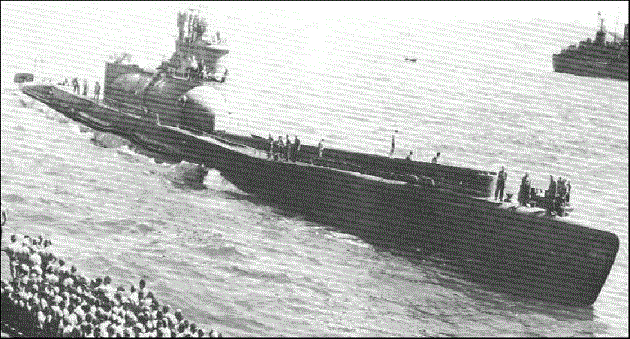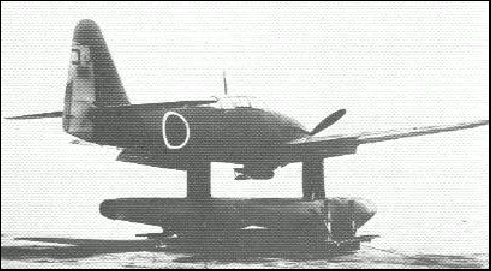


I-400 beside submarine tender USS Proteus after the war. Note the large hangar and forward catapult. (US Navy photo, scanned from Polmar and Carpenter's "Submarines of the Imperial Japanese Navy")
While Japan built many submarines that were larger than those of other Navies, the three Sen Toku boats were far larger than anything ever seen before. Some 60% larger than the largest contemporary American submarine, USS Argonaut, they had more than twice her range. The most unusual feature was that they each carried three floatplane bombers (and parts for a fourth), a feat never achieved by any other class of submarine. These aircraft folded to fit into the 115-foot cylindrical hangar, which was slightly offset to starboard and opened forward to access the catapult. The huge double hull was formed of parallel cylindrical hulls so that it had a peculiar lazy-eight cross section, and may have inspired the Soviet Typhoon-class built some 40 years later. Although aircraft must be considered their primary armament, they also carried a formidable torpedo battery and the usual 14cm deck gun. Anti-aircraft armament included ten 25mm cannons in three triple mounts and one single. Each of these boats had radar and a snorkel.
The aircraft were the Aichi M6A1 Seiran, also carried by the Type AM submarines. Each of these monoplanes could carry one aerial torpedo or a bomb weighing up to 800kg. Powered by the 1,400hp Atsuta 32 engine (similar to Germany's DB601) they had a top speed of 295mph and were credited with a range of 642 nautical miles. The Sen Toku submarines carried four aerial torpedoes, three 800kg bombs, and twelve 250kg bombs to arm these aircraft. These aircraft had their assembly points coated with fluorescent paint to ease assembly in the dark, so four trained men could prepare an aircraft for launch in seven minutes. All three aircraft could be prepared, armed, and launched in 45 minutes.

The Aichi M6A1 Seiran had the performance of carrier-based bombers, yet it was operated from a submarine. (Scanned from Rene J. Francillon's "Japanese Aircraft of the Pacific War")
Unfortunately for Japan, the war situation deteriorated so rapidly that these boats were never allowed to show what they could do. On 26 July 1945, I-400 and I-401 set out on a combat mission to launch their aircraft in Kamikaze attacks on the American fleet anchorage at Ulithi. In coordination with a Kaiten attack, they were scheduled to launch early on 17 August, but by then hostilities had ceased. Both boats therefore returned to Japan and were surrendered to the Allies. After the war, these two were taken to the United States, examined, and finally scuttled in the Pacific in 1946. I-402 was converted to carry precious fuel to Japan from the East Indies, but never performed such a mission. She was scuttled off Goto Island in 1946. Construction of two further boats of this design, I-404 and I-405, was stopped before completion, although I-404 was 90% complete. A further 13 boats were canceled before construction started.
| Units | 3 (all survived) |
|---|---|
| Ships | I-400, I-401, and I-402 |
| Year(s) Completed | 1944-1945 |
| Displacement | 5,223 tons / 6,560 tons |
| Dimensions | 400.3 ft x 39.3 ft x 23 ft | Machinery | 4 diesels: 7,700 hp
electric motors: 2,400 hp |
| Speed | 18.75 knots / 6.5 knots |
| Range | 37,500 nm @ 14 knots |
| Armament | 8x533mm TT fwd + 1x14cm/50 cal. (20 torpedoes). |
| Max. Depth | 100 m (330 feet) |
| Crew | 144 officers and men |
Additional Info
Discovery of I-400
Links From Related Partner Sites
I-400-class Submarine
* I-400
* I-401
* I-402
 |  |  |  |  |
 |  |  |  |  |
See all photos of I-400-class Submarine on WW2DB

